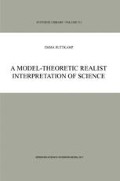Abstract
At least the fact that the model-theoretic notion of a scientific theory as a deductively closed set of sentences is also a feature of theories accepted by the advocates of the statement account of science seems to imply that model-theoretic realism might overlap with their views also in other ways. Well, for one thing, a defender of model-theoretic account of science also looks to a semantic analysis of scientific language to fulfil her goals. Defenders of model-theoretic realism, however, also want to be realists, and so they want something better (or “more”) than Carnap’s (1966, p.256) rather noncommittal view of the instrumentalist-realist debate:
My own view... is that the conflict between the two approaches is essentially linguistic. It is a question of which way of speaking is to be preferred under a given set of circumstances. To say a theory is a reliable instrument — that is, that the predictions of observable events that it yields will be confirmed — is essentially the same as saying that the theory is true and that the theoretical, unobservable entities it speaks about exist.
Access this chapter
Tax calculation will be finalised at checkout
Purchases are for personal use only
Preview
Unable to display preview. Download preview PDF.
Notes: Chapter 3
As we shall see in Chapter 4, the model-theoretic view on this is that meta-mathematics is model theory, which, in a sense is set theoretical, so that the statement non-statement distinction becomes more one of emphasis, than of real differences.
Remember that Cartwright takes scientific theories to be a set of fundamental laws — like Maxwell’s equations — from which explanations in physics are supposed to start. See Chapter 4.
This is one more reason for the importance of theories or fundamental laws in the process of science. One theory may have infinitely many “incompatible” models (i.e. models that are not isomorphic) and “the facts” may be valid in all of these.
Recall that for Carnap the choice of such frameworks is a pragmatic matter. Also important is that Maxwell (1962) demanded that a linguistic framework should be broad enough to allow for the development of explanations of phenomena in terms of novel empirical predictions.
Psillos (ibid.) notes that Carnap had to posit this identity between theoretical and mathematical concepts, because he believed at all costs that a linguistic framework for analysing the language of science must be broad enough to include future theoretical concepts. Given this identity, new physical concepts can be taken up in this framework, since we can provide the relevant extensionally identified mathematical functions, since the extensional language Lr is such that any physical magnitude of any logical type will be identifiable with a certain mathematical function. This also allows for comparison of theories in the sense of finding mathematical functions corresponding to different theoretical concepts and examining whether these functions are extensionally identical.
See Psillos’s (ibid.) comments in terms of Carnap’s method of extension and intension on Feigl’s criticism of Carnap’s “instrumentalist” interpretation of Ramsey sentences in the sense that it seems that Camap takes theories to be mathematical models with observable phenomena embedded in them.
Note that A-postulates do not tell us anything about the physical world, but merely specify the meaning relations holding between the descriptive terms of our language.
So this sentence AT which contains all T-terms, together with the Ramsey sentence (or FT) which contains no T-terms, say just as much as the postulate TC.
Any n-tuple of entities that satisfies this formula, under the fixed standard interpretations of its 0-terms, may be said to realise,or to be a realisation of the theory T“ (ibid.).
The Löwenheim-Skolem Theorem, simply formulated, states that if we let F be a set of formulae in first-order logic such that there is an infinite a with a a model of F, then there are models (3 of arbitrary infinite cardinalities such that ß is a model of F. This implies then that a theory with an infinite model has infinitely many non-isomorphic models.
Poincarés term originally.
Author information
Authors and Affiliations
Rights and permissions
Copyright information
© 2002 Springer Science+Business Media Dordrecht
About this chapter
Cite this chapter
Ruttkamp, E. (2002). The Statement Account of Science. In: A Model-Theoretic Realist Interpretation of Science. Synthese Library, vol 311. Springer, Dordrecht. https://doi.org/10.1007/978-94-017-0583-7_3
Download citation
DOI: https://doi.org/10.1007/978-94-017-0583-7_3
Publisher Name: Springer, Dordrecht
Print ISBN: 978-90-481-6066-2
Online ISBN: 978-94-017-0583-7
eBook Packages: Springer Book Archive

